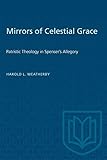Mirrors of Celestial Grace : Patristic Theology in Spenser's Allegory / Harold L. Weatherby.
Material type: TextSeries: HeritagePublisher: Toronto : University of Toronto Press, [1994]Copyright date: ©1994Description: 1 online resource (288 p.)Content type:
TextSeries: HeritagePublisher: Toronto : University of Toronto Press, [1994]Copyright date: ©1994Description: 1 online resource (288 p.)Content type: - 9781487573003
- 9781487584818
- 821/.3 20
- online - DeGruyter
| Item type | Current library | Call number | URL | Status | Notes | Barcode | |
|---|---|---|---|---|---|---|---|
 eBook
eBook
|
Biblioteca "Angelicum" Pont. Univ. S.Tommaso d'Aquino Nuvola online | online - DeGruyter (Browse shelf(Opens below)) | Online access | Not for loan (Accesso limitato) | Accesso per gli utenti autorizzati / Access for authorized users | (dgr)9781487584818 |
Browsing Biblioteca "Angelicum" Pont. Univ. S.Tommaso d'Aquino shelves, Shelving location: Nuvola online Close shelf browser (Hides shelf browser)

|

|

|

|

|

|

|
||
| online - DeGruyter Proceedings of the Second International Conference on the International Society for Terrain-Vehicle Systems / | online - DeGruyter Square John : A True Story / | online - DeGruyter Unwrapping Balzac : A Reading of La Peau de Chagrin / | online - DeGruyter Mirrors of Celestial Grace : Patristic Theology in Spenser's Allegory / | online - DeGruyter Natural Gas and National Policy : A linear programming model of North American natural gas flows / | online - DeGruyter Aspects of Music in Canada / | online - DeGruyter Making Canadian Indian Policy : The Hidden Agenda 1968-1970 / |
restricted access online access with authorization star
http://purl.org/coar/access_right/c_16ec
Much has been written about Spenser's theological allegory and its sources but, until now, no one has suggested sustained patristic influence. Harold Weatherby argues that taking patristic theology as a measure for certain episodes in The Faerie Queene affords more convincing evidence than the familiar (usually Protestant) references. He shows that sixteenth-century editions of the works of the principal Fathers were available to Spenser, and that, in addition, there appeard to be considerable interest in the Fathers at Spenser's college, Pembroke. With the additional evidence of the poem itself, Weatherby introduces the theory that patristic theology affected the poet's understanding of Christianity. To demonstrate, the author examines seven allegorical episodes in The Faerie Queene, each of which has had extensive pervious interpretive attention, quite different from the approach taken here. He looks closely at the dragon fight and the figure of St George; the subsequent nuptial celebration with Una and Red Crosse; the role of Belphoebe as an emblem of temperance (as the Fathers conceive temperance); Guyon's descent into Mammon's cave; Guyon's encounter with Mordant, Amavia, and Ruddymane, and his futile effort to cleanse the child's hands; Arthur's defeat of Maleger; and the presentation of Dame Nature. In each of these episodes, patristic thought is seen to have significantly shaped the allegory. The epilogue suggest how patristic thought influenced Spenser's presentation of eros in Books III and IV, introducting a new hypothesis about these books and about Spenser's conception of chastity.
Mode of access: Internet via World Wide Web.
In English.
Description based on online resource; title from PDF title page (publisher's Web site, viewed 01. Nov 2023)


